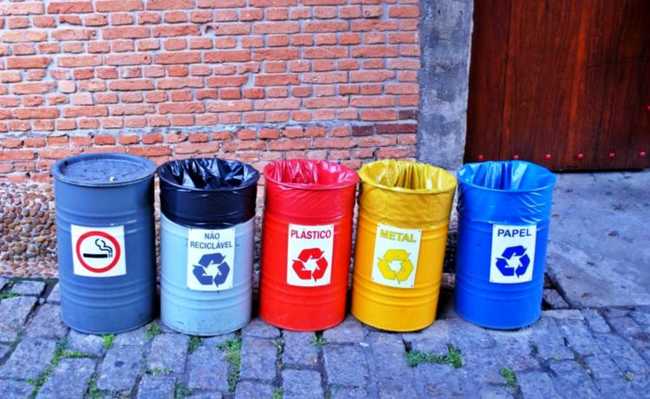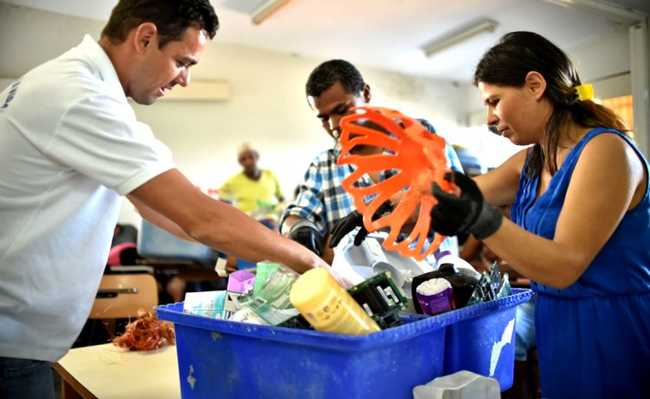What is selective collection?
Find out how and why it is important to contribute to selective collection

Image: Selective collection cans in the main corridor of Sesc Pompeia by Flavio Boaventura licensed under (CC BY-SA 2.0)
Selective collection is a method that optimizes waste disposal processes. And speaking of garbage... It is worth noting that "garbage" is a general word to designate the words "waste" (discards that still have some possible use through recycling or reuse) and "reject" (those that can no longer be used again).
- Recycling: what is it and why is it important
The importance of selective collection is precisely the reduction of the environmental impacts of consumption. When we separate garbage (or what's left over from what we consume), we make it much easier to treat and reduce the chances of harmful impacts on the environment and on the health of life on the planet, including human life. Practicing selective collection is one of the pillars of sustainable consumption.
The importance of selective collection

Image: Members of selective collection cooperatives participate in training by Andre Borges/Agência Brasília licensed under (CC BY 2.0)
Selective collection requires that waste is separated into wet, dry, recyclable and organic. And within these categories there are subcategories. Recyclables, for example, include aluminum, paper, cardboard and some types of plastic, among others. When recyclable materials are collected and arrive at the cooperatives, they are carefully separated for reuse. What is not reused is taken to landfills.
- Garbage separation: how to properly separate garbage
Hazardous materials such as batteries and electronics, when improperly disposed of, significantly pollute the soil, water and sometimes even the air.
- Water pollution: types, causes and consequences
- Soil Pollution: Know Causes and Consequences
- What is air pollution? Know causes and types
The National Solid Waste Policy (PNRS) provides for the non-generation of solid waste and, when generated, the final disposal that is environmentally appropriate. For this, the PNRS establishes that the responsibility for the life cycle of the products must be shared, that is, all - manufacturers, importers, distributors, traders, consumers and holders of public urban cleaning services - are responsible for the environmentally adequate final disposal of the solid waste.
The same law establishes that there is integration and economic emancipation of reusable material collectors in the life cycle of products. Thus, the importance of selective collection is also at the economic-social level.
The city does not collect reusable material. What to do?
It is not necessary to wait for the city to offer selective collection services to provide the most appropriate disposal for its waste. Together with the residents of your condominium or employees of your company, it is possible to implement selective collection. Understand more about this topic in the articles: "Selective collection in condominiums: how to implement it", "Instituto Muda: selective collection in companies and condominiums" and "Selective collection project: requirements and implementation" - and in the PDF manual "Basic guide to selective collect".
Did you stop and think that the implementation of selective collection in your condominium could be expensive? Know that, on the contrary, if you also implement recycling, it is possible to get financial resources for the condominium. Understand this theme better in the articles: "The first five steps to start recycling" and "Solutions for selective collection in condominiums".
Companies specializing in selective collection
To facilitate the implementation of selective collection and conscientious waste management, there are specialized companies that offer a specific project to enable selective collection in condominiums and companies. The cost/benefit ratio ends up paying off, considering the increased efficiency of the process, in addition to other benefits.
In São Paulo, a company that works with a selective collection project is Instituto Muda. Since 2007, they have been carrying out the diagnosis and the project to adapt the necessary infrastructure for packaging recyclables. The implementation includes lectures and training, collection of recyclable materials, monthly waste report, in addition to a certificate of correct disposal.
If you are interested in the work of Instituto Muda and would like to make a quotation for the management of your condominium or company, fill out the form below and a representative will contact you.
To find out which collection points are closest to your home, access the free search engines at eCycle portal .










